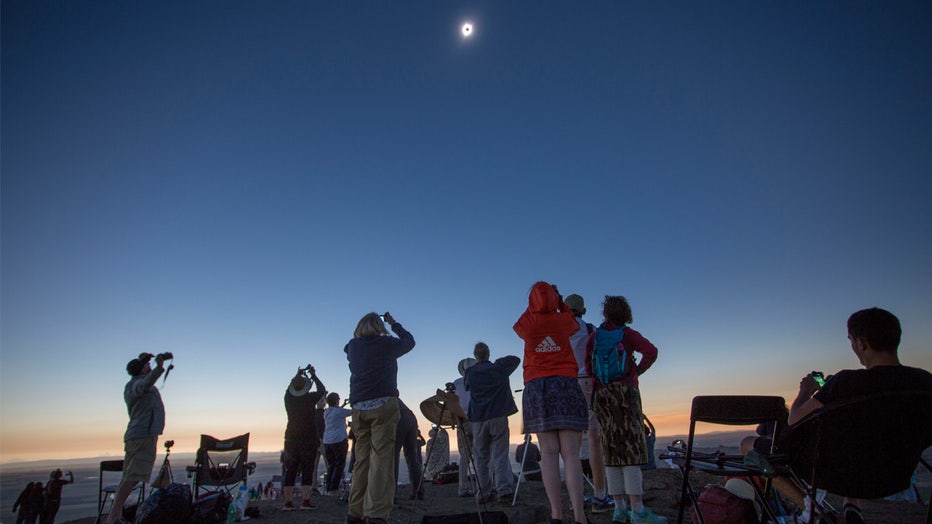Solar eclipse 2024: Which NY cities are in path of totality, what NYC will experience April 8

Solar eclipse excitement in New York
The solar eclipse of 2017 did not disappoint. While New York was not in that path of totality that stretched diagonally across the country, New Yorkers were still treated to a partial eclipse. The pesky clouds ultimately cleared out and we got a good look when the moon blocked out most of the sun.
NEW YORK - The Great North American Eclipse is less than three months away, and several towns across New York are in the path of totality.
And while the total phase of the solar eclipse is not visible in NYC, it can be seen as a partial solar eclipse – similar to (but better than!) our experience in 2017.

The sun is eclipsed by the moon over top of the Empire State Building in New York City on August 21, 2017. (Photo by Gary Hershorn/Getty Images)
Here's what you need to know if you're traveling to see the total solar eclipse -- and what you'll see if you stay in the NYC area.
When is the solar eclipse 2024?
On April 8, 2024, "the greatest natural event you can see" will traverse parts of the United States, Mexico and Canada.

Total eclipse of the sun at the location of the longest duration of 2 minutes and 40 seconds in Hopkinsville, KY, Aug. 2017. (Photo by Jonathan Newton / The Washington Post via Getty Images)
What is a total solar eclipse?
During a total solar eclipse, the moon passes completely in front of the sun, momentarily turning day into night for those in the path of its shadow – like someone just turned off a light switch.
The path of the 2024 eclipse is about 115 miles wide and will span from Mexico to Maine.
In New York, the path of totality starts near Allegheny State Park, cuts through to include Syracuse but leaves out Utica, then leaves the state through Adirondack Park.

Locals and travelers from around the world gather on Menan Butte to watch the eclipse on Aug. 21, 2017 in Menan, Idaho. (Photo by Natalie Behring/Getty Images)
A total solar eclipse is a rare event: any given spot on Earth will only see a total solar eclipse about once every 400 years.
More than 31 million people live in the path of this year’s shadow, also known as the path of totality, and millions more are expected to flood towns in the eclipse’s path.

The sun rises next to the Statue of Liberty during an annular eclipse on June 10, 2021 in New York City. (Photo by Gary Hershorn/Getty Images)
Where to see the solar eclipse in New York?
There are several cities and towns in the path of totality across New York. Here’s a look at them, according to NASA, the U.S. Navy and state tourism websites.
- Buffalo
- Jamestown
- Rochester
- Syracuse
- Watertown
- Lake Placid
- Plattsburgh
Can I see the solar eclipse in NYC?
The total phase of the solar eclipse is not visible in New York City but can be observed as a partial solar eclipse.
- 2:10 p.m. – The event begins the moment the edge of the moon touches the edge of the sun.
- 3:25 p.m. – The maximum view (the deepest point of the eclipse) with the Sun at its most hidden.
- 4:36 p.m. – The event ends when the edge of the moon leaves the edge of the sun.
The total duration of the event in New York City will be two hours and 26 minutes.
What other US states are involved?
The moon’s shadow will first touch Mexico at Mazatlan, then enter the United States through Texas.

(NASA)
From there, it cuts diagonally through parts of Oklahoma, Arkansas, Missouri, Kentucky, Illinois, Indiana, Ohio, New York, Pennsylvania, New York, Vermont, New Hampshire and Maine. Small parts of Tennessee and Michigan will also see a total solar eclipse, according to NASA.
Why you should get in the path of totality
When it comes to a total solar eclipse, according to experts, getting near the path of totality just doesn’t cut it.
"If you can get yourself into the path of the moon’s shadow for a total eclipse, it’s definitely worth the effort," Rick Fienberg, project manager of the American Astronomical Society’s Solar Eclipse Task Force, told FOX Weather. "A 99% partial solar eclipse doesn’t get you 99% of the experience of a total solar eclipse — that last 1% is literally the difference between night and day."
When the moon hides the sun, the temperature suddenly drops. Stars and planets that are usually only visible at night will emerge. Even animals are tricked into believing it’s nighttime, NASA said. The totality lasts less than 10 minutes.
When is the next total solar eclipse?
If you miss it, the next time a total solar eclipse will be visible in the U.S. is Aug. 12, 2045.
LiveNOW and FOX Weather helped contribute to this report.

